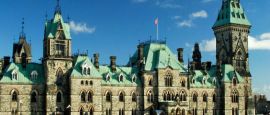Ottawa History
The name Ottawa is derived from the Algonquin word adawe, meaning "to trade". For centuries, Algonquin people navigated the waterways of the Ottawa and Rideau rivers but there was no settlement here until the 1800s when Gatineau was founded near the falls, across the river from present-day Ottawa.
Ottawa was started as a settlement after a navigable waterway between Lake Ontario and the Ottawa River was completed in 1831. Many of the builders were Scottish stonemasons who lived in Ottawa, then known as Bytown.
After its humble beginning as a small lumber town, Ottawa was designated Canada's capital by Queen Victoria in 1857. Four years later, the population hit 15,000 but settlers in the surrounding regions numbered almost 50,000.
Soon, sawmills built by lumber barons would become some of the largest mills in the world. The lumber industry continued to contribute to Ottawa's growth and lasted until shortly after the turn of the century, after which it slowly fell into decline.
Around the same time, the city saw a rise in the creation of new government departments. Between 1860 and 1876, construction of the parliament buildings took place on Parliament Hill. Although fire destroyed the Centre Block of the Parliament buildings in 1916, a replacement was completed in 1922, the centrepiece of which is the gothic-inspired Peace Tower located on Wellington Street.
In 1867, the Province of Canada ceased to exist and the provinces of Quebec and Ontario were formed. They united with Nova Scotia and New Brunswick to form Canada. The arrival of the railways in the late 19th century enabled the city to become a key destination on a transcontinental network. By 1901, the city was the fourth largest in Canada.
A building boom in the 1960s and 70s saw a transformation of the city’s skyline. In the 1970s the high tech sector drew highly skilled workers to this burgeoning computer and telecommunications centre, giving birth to Silicon Valley North. Today, technology, government and health are the major sources of employment.
Did you know?
• The Dutch gave 100,000 tulip bulbs to Ottawa in 1945 as thanks for sheltering the Dutch royal family during WWII.
• A fire destroyed most of the original Parliament Building in 1916, except for the library which survived as an employee closed its huge steel doors.
• In 1929, there were a number of explosions in Ottawa’s sewers. Blasts sent manhole covers and flames into the air and killed one person.
Do you have any Feedback about this page?
© 2025 Columbus Travel Media Ltd. All rights reserved. No part of this site may be reproduced without our written permission, click here for information on Columbus Content Solutions.




 You know where
You know where